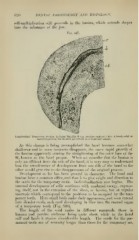Page 610 - My FlipBook
P. 610
620 DENTAL EMBRYOLOGY AND HISTOLOGY.
cell-multiplication still proceeds in the lamina, ^vhich extends deepei
into the substance of the jaw.
Fig. 347.
Longitudinal Transverse Section Inferior ^laxilla (^ cm. porcine embryo X 40): b, band, solid a(
anterior portion, but divided posteridrly into band and lamina.
As this change is being accomplished the band becomes somewhat
shallower and in some instances disappears, the more rapid growth of
the lamina apparently causing the straightening of the outer base of the
W, known as the bund ])roper. When we consider that the lamina is
only an offshoot from the side of the band, it is very easy to understand
how the transferrence of development from one side of the band to the
other would give rise to the disappearance of the original process.
Development so far has been general in character. The band and
lamina have a common office, and that is to give origin and direction to
the cords for tlie temporary teeth. Individualization now begins. The
intei'ual development of cells continues with unabated energy, express-
ing itself, not in the extension of the sheet, or lamina, Init at regular
intervals which correspond to the ]iositions to be occupied by the tem-
porary teeth. Here small buds make their appearance, and soon extend
into slender cords, each cord developing in time into the enamel organ
of a temporary tooth (Fig. 348).
The length of the cord varies in different mammals, those in
human and porcine embryos being quite short, while in tlie foetal
calf and lamb it attains considerable length. The cords for the per-
manent teeth are of necessity longer than those for the temporary set,


